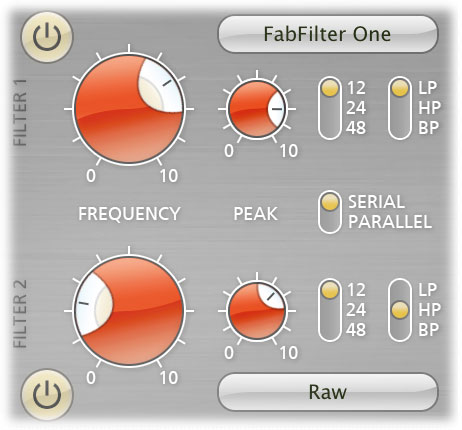FabFilter Simplon online help
Table of contents
Go to sectionFabFilter Simplon Help
Introduction
Using FabFilter Simplon
Presets
Purchasing FabFilter Simplon
Support
Filters
FabFilter Simplon comes with two high quality filters, each featuring various sound characteristics. These multimode filters sound the same as our award winning filters used in the FabFilter One and FabFilter Volcano. You can use them individually or combine filter characteristics to create your own sounds. To get the best out of Simplon, you need to give it something rich in harmonics (synth sounds, distorted guitar and complete mixes are good sources for filtering).

You control each filter with the following settings:
- Frequency and Peak
The filter frequency is adjustable from 5 Hz to 75 kHz with variable resonance (yes, it will self-oscillate at maximum resonance!). The Frequency knob controls the center frequency of each filter. The Peak knob adjusts the filter resonance. A little resonance will cause the filter to create warmer and more characteristic tones. Both knobs can be controlled in real time, either manually or via external devices. -
Characteristic
You can choose between three different filter characteristics:
- FabFilter One is the original filter characteristic taken from our award-winning FabFilter One synthesizer. It's perfect for general usage.
- Gentle, with a more smooth and clean characteristic.
- Raw has lots of overdrive and exhibits a character of its own.
- Response
The response of each filter can be set to either Low Pass, High Pass, or Band Pass. In Low Pass mode, the filter will pass through frequencies lower than the center frequency. In High Pass mode, frequencies higher than the center frequency will be passed through. In Band Pass mode, only the frequencies around the cut-off frequency will be passed through. - Slope
The slope switch sets the steepness of the filter, which controls how aggressively the frequencies around the center frequency are filtered. You can choose between 12 dB/octave, 24 dB/octave or 48 dB/octave settings. For example, if the response is set to Low Pass, more high frequencies will remain at 12 dB/octave than at 48 dB/octave. - Bypass
The two filters can each be switched on or off with the small buttons left of the characteristics drop-down menu in the filter section. While a filter is bypassed, it will look disabled, but the controls can still be used to adjust the filter. Bypassing the filters is click-free.
Linking the two filters
When you want to change the Frequency and the Peak setting of both filters
simultaneously, just hold down the Alt key while turning a knob. For example, you can set
them up as dual, resonant band-pass filters and sweep the cutoffs simultaneously. This
configuration will give you access to all manner of 'vocal' sounds, as well as even more dramatic
formant-based timbres.
To adjust both filters simultaneously, but in the opposite direction hold down the Ctrl
and Alt keys (Windows) or the Command and Alt keys (Mac) and drag the knob
for filter 1 or 2.
